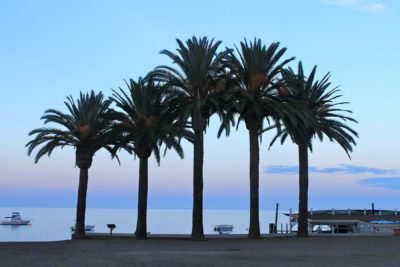
 Isn’t it weird to think of Catalina Island without palm trees lining the sandy beaches? Well a hundred years ago, that’s how it would have been! Maybe a shocker, but palm trees are not native to the island, they were brought to Catalina for aesthetic and filming purposes.
Isn’t it weird to think of Catalina Island without palm trees lining the sandy beaches? Well a hundred years ago, that’s how it would have been! Maybe a shocker, but palm trees are not native to the island, they were brought to Catalina for aesthetic and filming purposes.
Many of the palm trees found in regions like Two Harbors were planted in the 1930s by movie production companies because the isthmus was such a popular filming location. Palm trees helped to make the island look more tropical than the semi-arid desert it really is, and it added a visual appeal of healthy, lush vegetation. In general, many palm trees were added around southern California because the trees were alluring and beautiful, but there wasn’t a worry of invasive root systems that could damage pipes or concrete, and there wasn’t obscene dropping fruit.
In Avalon specifically, Philip Wrigley encouraged much of the palm tree scene in the main city. After the Casino was completed, Wrigley authorized 100 full-sized palm trees to be planted around the Casino and on the boardwalk leading up to it. The trees were brought over to the island on barges and had to be lifted into place by tractors and cranes. Palm trees were seen as a sign of leisure and encouraged tourism to the isolated hot-spot off of bustling Los Angeles.
 There are many species of palms that now populate the island including fan palms and the iconic trees that line Toyon’s waterfront, the Canary Island Date Palms. This species of palm seeds was actually brought to California in the 1700s from a Spaniard, Father Junipero Serra. He stopped at the Canary Islands off the coast of Africa, which Spain controlled, and brought palm seeds to plant around new missions in the Americas. Their fronds may have been used in Palm Sunday celebrations, but they were mostly planted for beauty and landscaping, which made them very popular. Even though these trees are not naturally found on the island, they have become a part of Catalina Island’s image and ecosystem. Paintings of Catalina often feature palm trees lining the streets or the beaches, and they still seem to give that tropical island feel to this southern California location. Even birds like the acorn woodpeckers use the trees as a storage facility, and rodents quickly designate palm trees as good homes.
There are many species of palms that now populate the island including fan palms and the iconic trees that line Toyon’s waterfront, the Canary Island Date Palms. This species of palm seeds was actually brought to California in the 1700s from a Spaniard, Father Junipero Serra. He stopped at the Canary Islands off the coast of Africa, which Spain controlled, and brought palm seeds to plant around new missions in the Americas. Their fronds may have been used in Palm Sunday celebrations, but they were mostly planted for beauty and landscaping, which made them very popular. Even though these trees are not naturally found on the island, they have become a part of Catalina Island’s image and ecosystem. Paintings of Catalina often feature palm trees lining the streets or the beaches, and they still seem to give that tropical island feel to this southern California location. Even birds like the acorn woodpeckers use the trees as a storage facility, and rodents quickly designate palm trees as good homes.
On the interior of the island, where there are few inhabitants, the goal of the conservancy is to keep the island as close to its natural state as possible. Invasive and introduced species that do not represent original Catalina vegetation are purposefully removed, so when possible palms are dug up to prevent spreading. I think it is safe to say however, that the palm trees of Toyon, Avalon, and Two Harbors will remain special icons and be there for many years to come.
Written by: Jaclyn Lucas


